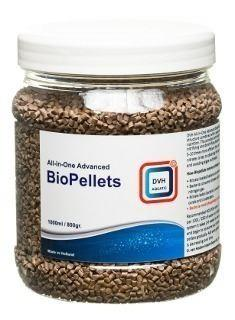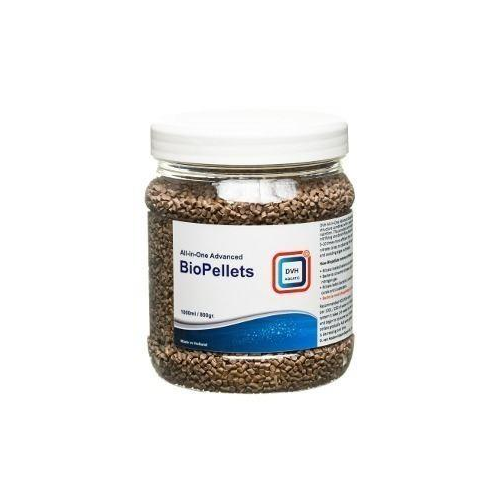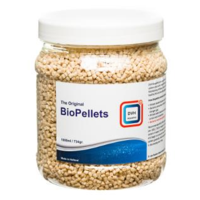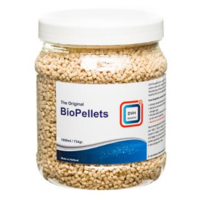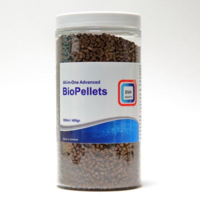DVH All In One Advanced BioPellets 1000ml (800g)
Previously, we were the first to develop and present the NP reducing Biopellets which are mostly removing Nitrogen waste products and to a small extend also Phosphates. Where our competitors lifted on our success and sit back, we kept developing our product.
 Now we are pleased to say that after 4 years of research we can present the All-In-One Biopellets (Patent Pending), which can be used to more efficiently remove both Nitrogen (5x) as well as Phosphates (10x-20x) without the need of using separate phosphate removing substrates.
Now we are pleased to say that after 4 years of research we can present the All-In-One Biopellets (Patent Pending), which can be used to more efficiently remove both Nitrogen (5x) as well as Phosphates (10x-20x) without the need of using separate phosphate removing substrates.
The positive effects of NP-reducing BioPellets on water quality are based on the principle of immobilization. Waste products from the water, mainly nitrate and phosphate, are converted into bacteria. This keeps the aquarium water clean. The new formula All-In-One Biopellets are composed of highly purified compounds, to ensure the save use of our products in marine tanks occupied by sensitive and precious animals such as corals, invertebrates, fish etc…
The pellets will allow aerobic growth of bacteria which consequently will consume nitrate and phosphate simultaneously. The bacteria will use up the carbon from the All-In-One Biopellets, whilst nitrogen and phosphorus are taken from the water as nitrate and (ortho)phosphate. This conversion of organic BioPellets (together with inorganic nitrogen and phosphorus) into microbial biomass is called immobilization. In contrast to our “old” Biopellets, we have observed that the All-In-One Biopellets work best with very high water flow. For example, a 700 liter tank with a fluidized filter containing 2 liter of All-In-One Biopellets already requires a minimal flow through of 2000-3000 l/h. On Note, this particular tank contains approximately 50 fish and after 10 months of testing both nitrates and phosphates were undetectable with standard nitrate and phosphate kits.
The surplus of bacteria will be consumed by filter and suspension feeding organisms, such as sponges and corals, or skimmed off by a protein skimmer. In addition, with a high feeding regime, we advise to use a simple filter sponge on the outlet of your fluidized filter to remove excess of bacteria which will otherwise cloud your water slightly.
On average the All-In-One Biopellets takes 1-4 weeks to give rise to sufficient bacteria to allow nitrate and phosphate levels to drop. Importantly, allow your aquarium inhabitants to adjust to their new environment by slowly increasing the level of BioPellets over a period of several weeks. Add extra pellets every 3-6 months dependent on Biopellet consumption and levels of NO3 and PO4.
| How it works |
| BioPellets are consumed by bacteria, which is why new pellets need to be added every 6-12 months to compensate for digested filtermedia. This can be seen during inspection of the filter or when you measure a increase of nitrates. These figures however depend on aquarium conditions and are strongly influenced by feeding regimes and livestock. Taking regular measurements of both nitrate and phosphate levels in the aquarium is recommended, after which dosages may be increased or decreased.Of Note, our NP-reducing BioPellets and the XL version consist of a higher molecular mass than most competing products resulting in a longer filter retention time and thus requires less frequent refill then other low molecular weight products which are currently being marketed.
Overview of biological activity on BioPellets. We suggest placing the outlet of the pellet filter in front of a protein skimmer, to limit the amount of bacteria entering the system. This has the additional benefit of increased gas exchange (CO2-removal and O2-addition). The pellets should never be used without sufficient aeration, as this may lead to low oxygen and pH levels, especially during night time. Proper aeration can be established with air pumps and protein skimmers. Our BioPellets will allow more feeding (See figure) and thus more livestock, however, when heavy feeding is required, it is recommended to combine the pellets with standard phosphate adsorbents. The reason for this is that most aquarium feeds contain higher levels of phosphate than is consumed by bacteria, fish and invertebrates, when compared to nitrogen. Some phosphate adsorbents however deplete alkalinity and may reduce pH. Using phosphate adsorbent media based on iron hydroxide does not have this disadvantage. The All-in-One BioPellets already containing a phosphate remover which makes the use of an additional in most situations unnessesary.
Example of nitrate and phosphate reduction in experimental 500 L tank set-up with 2 liter of BioPellets. In week 10 we doubled the feed input. You can't overdose* the BioPellets. Once your filtersystem is working optimal, the number of bacteria fluctuate according to the availability of nitates and phosphates. When the availability of nitrates and phosphates is low, the numbers of bacteria will decrease. When more nitrates and phosphates come available due to eg. feeding the numbers of bacteria will increase again as you can see in the example below.
|
What makes the All-in-One BioPellets different from the standard pellets ? This is the simple and easy to understand version. What we managed to do is to combine the NP Reducing BioPellets with the active ingredient of phosphate remover. As any organism need phosphates as a building block to allow growth, including bacteria, this makes this combination a win-win situation. Like with the standard NP Reducing BioPellets, as well as the NP Reducing BioPellets XL, the bacteria consumes the pellets for the carbon so they can multiply. At the same time they consume the nitrates and some phosphates from your water column which will lead to lower nitrate levels in your water.
In some systems people reported that the biopellets don’t work in their aquarium. This is meanly due to heavy phosphate removal from the water. As said before, any organism, including bacteria, need phosphates to allow growth. The new All-in-One BioPellets has the phosphate mover build in allowing the bacteria to utilize it for growth and reproduction at the same place as their carbon source. This is improve the nitrate removal with about 5x. As the bacteria consume the pellets, a new layer of -fresh- phosphate remover will be exposed for phosphate removal. This makes the All-in-One BioPellets unique in his kind. With this combination of phosphate removal by the bacteria and the removal by the All-in-One BioPellets we achieved to increase the phosphate removal from the water column by 10-20x compared to the standard NP Reducing BioPellets and the NP Reducing BioPellet XL.
Please allow your aquarium inhabitants to adjust to their new environment by slowly increasing the level of BioPellets over a period of several weeks.
(592)
| SKU | 592 |
| Barcode # | 094922671080 |
| Brand | DVH Aquatic |
| Shipping Weight | 2.0000kg |
| Shipping Width | 0.140m |
| Shipping Height | 0.080m |
| Shipping Length | 0.260m |

